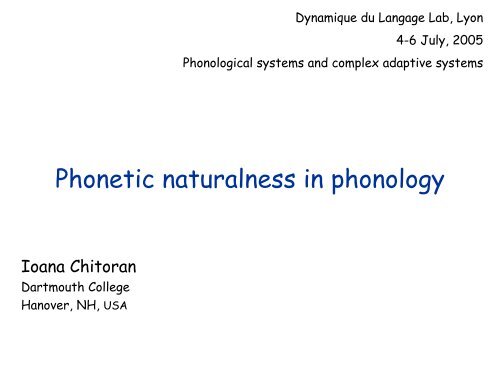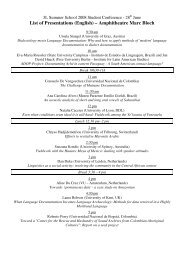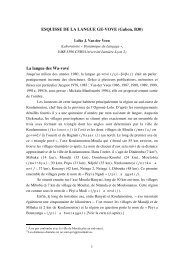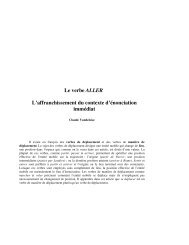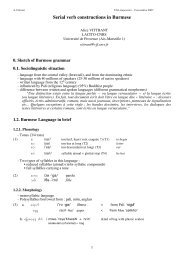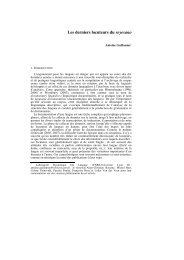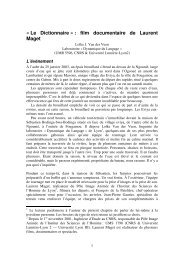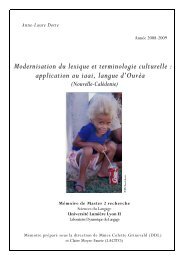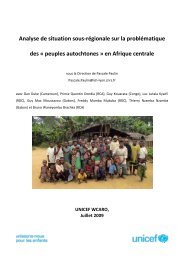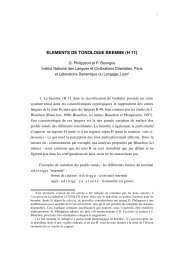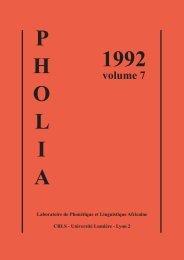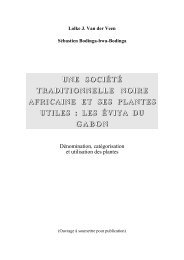Phonetic naturalness in phonology - DDL
Phonetic naturalness in phonology - DDL
Phonetic naturalness in phonology - DDL
You also want an ePaper? Increase the reach of your titles
YUMPU automatically turns print PDFs into web optimized ePapers that Google loves.
Dynamique du Langage Lab, Lyon<br />
4-6 July, 2005<br />
Phonological systems and complex adaptive systems<br />
<strong>Phonetic</strong> <strong>naturalness</strong> <strong>in</strong> <strong>phonology</strong><br />
Ioana Chitoran<br />
Dartmouth College<br />
Hanover, NH, USA
Why relevant?<br />
• Are phonetics and <strong>phonology</strong> separate systems, or not?<br />
• Are natural phonetic explanations directly encoded <strong>in</strong><br />
the <strong>phonology</strong>, or not?<br />
• Units (features, gestures, targets, trajectories…)<br />
� Nature of units:<br />
quantitative vs. qualitative<br />
discrete vs. cont<strong>in</strong>uous<br />
<strong>DDL</strong>, Lyon – Chitoran<br />
July 6, 2005<br />
2
Goals<br />
• To what extent is <strong>phonology</strong> natural?<br />
General agreement:<br />
Most phonological processes “make sense”, are natural, from the<br />
po<strong>in</strong>t of view of speech physiology, acoustics, and perception.<br />
• Focus on three major views:<br />
(i) Direct encod<strong>in</strong>g of phonetic detail and full <strong>in</strong>tegration of phonetic<br />
knowledge <strong>in</strong> <strong>phonology</strong> (e.g., Steriade 2000, 2001; Flemm<strong>in</strong>g<br />
1995, 2001; and others)<br />
(ii) Indirect reflection of phonetic detail <strong>in</strong> phonological constra<strong>in</strong>ts<br />
(e.g., Hayes 1999, Hayes & Steriade 2004)<br />
(iii) The issue of phonetic <strong>naturalness</strong> <strong>in</strong> diachrony (e.g., Ohala 1981,<br />
1989, 1990; Hyman 1977, 2001; Blev<strong>in</strong>s 2004)<br />
<strong>DDL</strong>, Lyon – Chitoran<br />
July 6, 2005<br />
3
(i) Phonology is natural<br />
Sound patterns can be entirely accounted for by pr<strong>in</strong>ciples of<br />
production and perception.<br />
Knowledge of quantitative phonetic details<br />
(unidimensional view; phonetic determ<strong>in</strong>ism)<br />
(ii) Phonology is natural, but not all of it<br />
Some constra<strong>in</strong>ts are phonetically grounded, but formal<br />
symmetry still plays a role <strong>in</strong> constra<strong>in</strong>t creation.<br />
Speaker/learner generalizes from experience <strong>in</strong> construct<strong>in</strong>g<br />
phonetically grounded constra<strong>in</strong>ts.<br />
(iii) Sound change is natural (but synchronic <strong>phonology</strong><br />
is not)<br />
<strong>DDL</strong>, Lyon – Chitoran<br />
July 6, 2005<br />
4
Constra<strong>in</strong>ts<br />
Both (i) and (ii) rely on Optimality Theory (OT)<br />
framework<br />
The formal characterization of an OT constra<strong>in</strong>t may <strong>in</strong>clude its<br />
motivation (unlike rules).<br />
(i) <strong>Phonetic</strong> and phonological constra<strong>in</strong>ts are evaluated the<br />
same way – by strict dom<strong>in</strong>ation (unlike Cohn 1998, Zsiga 2000).<br />
(ii) Phonological constra<strong>in</strong>ts can be rooted <strong>in</strong> phonetic<br />
knowledge.<br />
Constra<strong>in</strong>ts are constructed by speakers based on their knowledge<br />
of the physical conditions under which speech is produced and<br />
perceived. Constra<strong>in</strong>ts may be universal, not necessarily <strong>in</strong>nate.<br />
<strong>DDL</strong>, Lyon – Chitoran<br />
July 6, 2005<br />
5
Steriade 2001<br />
Asymmetry <strong>in</strong> loss of place contrasts expla<strong>in</strong>ed by<br />
perceptual cues.<br />
• Regressive assimilation<br />
anpa � ampa amta � anta<br />
a�pa � ampa amka � a�ka<br />
• Progressive assimilation<br />
an�a � anta a�ta � a��a<br />
<strong>DDL</strong>, Lyon – Chitoran<br />
July 6, 2005<br />
6
• C place cues <strong>in</strong> CV transitions (Ohala 1990)<br />
VCiCjV � VCjCjV<br />
*VCiCiV<br />
• Cues to apical/retroflex dist<strong>in</strong>ction <strong>in</strong> VC transitions<br />
(Ladefoged & Maddieson 1986)<br />
• P-map (Perceptual map)<br />
Speaker’s knowledge of the discrim<strong>in</strong>ability of contrasts:<br />
- which contrasts are more discrim<strong>in</strong>able<br />
- the same contrast is more salient <strong>in</strong> some contexts than <strong>in</strong> others<br />
Calculated as perceived similarity between two str<strong>in</strong>gs<br />
<strong>DDL</strong>, Lyon – Chitoran<br />
July 6, 2005<br />
7
Formal analysis<br />
• Indexed correspondence constra<strong>in</strong>ts<br />
major place contrast:<br />
IDENT[place]/C_V >> IDENT[place]/V_C<br />
apical/retroflex contrast:<br />
IDENT(anterior)/V[ _, apical, stop]C >><br />
IDENT(anterior)/C[ _, apical, stop]V<br />
See also Flemm<strong>in</strong>g (1995, 2001) for OT constra<strong>in</strong>ts referr<strong>in</strong>g to formant structure.<br />
<strong>DDL</strong>, Lyon – Chitoran<br />
July 6, 2005<br />
8
Hayes (1999)<br />
Inductive ground<strong>in</strong>g<br />
• Grounded constra<strong>in</strong>t = phonetically sensible<br />
i.e., Bans th<strong>in</strong>gs that are phonetically hard, allows th<strong>in</strong>gs that are<br />
phonetically easy (to produce)<br />
• Speaker constructs a phonetic (difficulty) map based on<br />
experience (e.g., for stop voic<strong>in</strong>g <strong>in</strong> 4 environments)<br />
• A number of constra<strong>in</strong>ts are derived from the phonetic map by<br />
<strong>in</strong>ductive ground<strong>in</strong>g<br />
• The effectiveness score of each constra<strong>in</strong>t is calculated by correct<br />
predictions / correct predictions+errors. Constra<strong>in</strong>ts with the<br />
highest scores are grounded (the best!), and will be reta<strong>in</strong>ed <strong>in</strong> the<br />
grammar.<br />
<strong>DDL</strong>, Lyon – Chitoran<br />
July 6, 2005<br />
9
Stop voic<strong>in</strong>g<br />
• Several constra<strong>in</strong>ts emerge as grounded:<br />
Highest score (1): *[+nasal][-voice] (postnasal voic<strong>in</strong>g)<br />
But see Hyman (2001) for postnasal devoic<strong>in</strong>g <strong>in</strong> Bantu.<br />
Only .6: *[LAB, -voice] no /p/<br />
*[DORS, +voice] no /g/<br />
Although these gaps are well attested (Maddieson 1984)<br />
Suggests that phonetic <strong>naturalness</strong> cannot be the sole criterion <strong>in</strong><br />
constra<strong>in</strong>t creation.<br />
<strong>DDL</strong>, Lyon – Chitoran<br />
July 6, 2005<br />
10
<strong>Phonetic</strong> <strong>naturalness</strong> <strong>in</strong> diachrony<br />
• Hyman (1977, 2001) <strong>Phonetic</strong> <strong>naturalness</strong> cannot be a<br />
property of synchronic phonologies. It is only relevant <strong>in</strong><br />
diachrony. A sound change, once phonologized, is<br />
subject to different pr<strong>in</strong>ciples (cf. also Anderson 1981)<br />
• Ohala (1981, 1989, 1990…) Common sound changes<br />
have direct phonetic sources.<br />
• Blev<strong>in</strong>s (2004) Evolutionary Phonology<br />
<strong>DDL</strong>, Lyon – Chitoran<br />
July 6, 2005<br />
11
<strong>Phonetic</strong> <strong>naturalness</strong> <strong>in</strong> diachrony<br />
• General agreement: sound change is phonetically<br />
natural<br />
Common examples:<br />
Tonogenesis (Hombert et al. 1979)<br />
Velar palatalization<br />
F<strong>in</strong>al obstruent devoic<strong>in</strong>g<br />
V nasalization before nasals<br />
Nasal place assimilation<br />
……<br />
Does phonetic <strong>naturalness</strong> persist <strong>in</strong> synchronic <strong>phonology</strong>?<br />
<strong>DDL</strong>, Lyon – Chitoran<br />
July 6, 2005<br />
12
Phonologization<br />
<strong>Phonetic</strong> � phonological � phonemic<br />
(phonologization) (phonemicization)<br />
[pa], [ba] [pa], [ba] [pa], [pa]<br />
H (L)H H LH H LH<br />
<strong>DDL</strong>, Lyon – Chitoran<br />
July 6, 2005<br />
(Contrast substitution)<br />
13
Evolutionary Phonology<br />
• Blev<strong>in</strong>s (2004) identifies 3 sources of sound change:<br />
(CCC Model)<br />
CHANGE<br />
CHANCE<br />
CHOICE<br />
Common sound patterns are phonetically based, can be<br />
expla<strong>in</strong>ed by speech perception and production.<br />
<strong>DDL</strong>, Lyon – Chitoran<br />
July 6, 2005<br />
14
• CHANGE – misperception<br />
production perception<br />
[anpa] [ampa]<br />
[ki] [t�i]<br />
[�] [f]<br />
• CHANCE – ambiguity of phonetic signal<br />
/a�/ - [�a��] [�a��] - /�a/<br />
• CHOICE – variation <strong>in</strong> the phonetic signal (L<strong>in</strong>dblom 1990, 1998)<br />
/ka-kata/ ‘to laugh’<br />
hyperarticulated: [kakata]<br />
hyparticulated: [kakata], [kkata]<br />
<strong>DDL</strong>, Lyon – Chitoran<br />
July 6, 2005<br />
15
Discussion<br />
• Phonologization comes closer to a full model (work<br />
subsequent to Hyman 1977: e.g., Barnes 2002)<br />
• Can expla<strong>in</strong> empirical observations<br />
• Addresses the relationship between synchrony and<br />
diachrony<br />
– A sound change which is purely phonetically motivated has<br />
consequences which may be exploited by synchronic<br />
<strong>phonology</strong><br />
<strong>DDL</strong>, Lyon – Chitoran<br />
July 6, 2005<br />
16
Examples<br />
• iV sequences <strong>in</strong> Romance languages (Chitoran & Hualde<br />
2002, 2005; Hualde & Chitoran 2003)<br />
• Patterns of gestural overlap <strong>in</strong> Georgian consonant<br />
clusters (Chitoran, Goldste<strong>in</strong>, Byrd 2002)<br />
– natural: overlap motivated by perceptual salience<br />
– unnatural: gesture separation is more than needed to preserve<br />
recoverability<br />
<strong>DDL</strong>, Lyon – Chitoran<br />
July 6, 2005<br />
17
iV/ sequences <strong>in</strong> Romance<br />
• Variability <strong>in</strong> the production of iV sequences<br />
French Spanish Romanian Catalan, Portuguese<br />
(Italian)<br />
[mj�p] [miope] [miopu] ‘short-sighted’<br />
[bjεl] [bjela] [biela] ‘rod’<br />
[medjan] ‘median’ [italjana] [italj/iana] ‘Italian’f.<br />
diphthong sequence<br />
(jV) (iV)<br />
<strong>DDL</strong>, Lyon – Chitoran<br />
July 6, 2005<br />
18
• Variability <strong>in</strong> syllabification judgments<br />
Standard French: all tautosyllabic<br />
Castilian Spanish: mixed (predom<strong>in</strong>antly tautosyllabic,<br />
Romanian: heterosyllabic<br />
Portuguese: heterosyllabic<br />
<strong>DDL</strong>, Lyon – Chitoran<br />
July 6, 2005<br />
tendency for heterosyllabic wd-<strong>in</strong>itially)<br />
19
Hypothesis<br />
• The observed difference <strong>in</strong> variability is related to<br />
two factors:<br />
- the presence of the glide [j] <strong>in</strong> a given language,<br />
from other historical sources;<br />
- effects of prosodic structure that affect the realization<br />
of the vocalic sequences.<br />
<strong>DDL</strong>, Lyon – Chitoran<br />
July 6, 2005<br />
20
Historical diphthongs<br />
Lat<strong>in</strong> /’pεtra/<br />
French Spanish Romanian Portuguese<br />
p[jε]rre p[je]dra p[ja]trə p[ε]dra<br />
<strong>DDL</strong>, Lyon – Chitoran<br />
July 6, 2005<br />
(with limited<br />
distribution)<br />
21
• Position <strong>in</strong> the word<br />
Prosodic effects<br />
– Vocalic sequences are longer word-<strong>in</strong>itially than word<strong>in</strong>ternally<br />
[d<strong>in</strong>#diana] > [mediana]<br />
• Position with respect to stress<br />
– Vocalic sequences are longer the closer they are to the ma<strong>in</strong><br />
stress syllable, preced<strong>in</strong>g it<br />
<strong>DDL</strong>, Lyon – Chitoran<br />
July 6, 2005<br />
[diákonu] > [diamántu] > [diagonál]<br />
22
Distribution of 5 Romance languages with respect<br />
to the acoustic duration of iV sequences (means)<br />
duration<br />
300<br />
280<br />
260<br />
240<br />
220<br />
200<br />
180<br />
160<br />
140<br />
120<br />
100<br />
<strong>DDL</strong>, Lyon – Chitoran<br />
July 6, 2005<br />
Sp<br />
Fr<br />
Rom<br />
EP<br />
BP<br />
shorter (medial)<br />
longer (<strong>in</strong>itial)<br />
23
The 5 languages are at different stages of variability.<br />
• <strong>Phonetic</strong> variability is enhanced <strong>in</strong> Spanish, where we<br />
see the contrast between diphthongs and sequences <strong>in</strong><br />
hiatus be<strong>in</strong>g lost (change <strong>in</strong> progress)<br />
• Contrast already lost <strong>in</strong> French<br />
• Contrast still ma<strong>in</strong>ta<strong>in</strong>ed <strong>in</strong> Romanian<br />
Importance of study<strong>in</strong>g variability, with<strong>in</strong> and across<br />
languages.<br />
<strong>DDL</strong>, Lyon – Chitoran<br />
July 6, 2005<br />
24
Patterns of gestural overlap <strong>in</strong> Georgian<br />
C1C2 clusters<br />
Affected by<br />
• Position <strong>in</strong> the word<br />
dgeba vs. adgeba<br />
less overlap word-<strong>in</strong>itially than word-medially<br />
• Order of place of articulation<br />
front-to-back back-to-front<br />
dgeba vs. gdeba<br />
p h t h ili vs. t h bili<br />
less overlap front-to-back than back-to-front<br />
Perceptual recoverability account<br />
<strong>DDL</strong>, Lyon – Chitoran<br />
July 6, 2005<br />
25
• Hyman (1977)<br />
Conclusion<br />
“Phonology is the <strong>in</strong>tersection of phonetics and grammar”<br />
phonetics<br />
<strong>phonology</strong><br />
grammar<br />
Some processes may be closer to here or here<br />
-<strong>in</strong> motivation (more or less natural)<br />
-<strong>in</strong> effect (more categorical or more gradient)<br />
<strong>DDL</strong>, Lyon – Chitoran<br />
July 6, 2005<br />
26
References<br />
• Anderson, S.R. (1981) Why <strong>phonology</strong> isn’t natural? L<strong>in</strong>guistic Inquiry 12:4, 493-539.<br />
• Barnes, J. (2002) Positional neutralization: A phonologization approach to typological<br />
patterns. PhD dissertation, UC Berkeley.<br />
• Blev<strong>in</strong>s, J. (2004) Evolutionary Phonology. Cambridge: Cambridge University Press.<br />
• Chitoran, I., L. Goldste<strong>in</strong>, and D. Byrd (2002) Gestural overlap and recoverability:<br />
Articulatory evidence from Georgian. In C. Gussenhoven and N. Warner (eds.) Papers <strong>in</strong><br />
Laboratory Phonology 7. 419-447. Berl<strong>in</strong>: Mouton de Gruyter.<br />
• Chitoran, I. and J.I. Hualde (2002)<br />
• Chitoran, I. and J.I. Hualde (2005)<br />
• Cohn, A. (1998) The phonetics-<strong>phonology</strong> <strong>in</strong>terface revisited: Where’s phonetics? Texas<br />
L<strong>in</strong>guistic Forum 41: 25-40.<br />
• Flemm<strong>in</strong>g, E. (1995) Auditory features <strong>in</strong> <strong>phonology</strong>. PhD dissertation, UCLA.<br />
• Flemm<strong>in</strong>g, E. (2001) Scalar and categorical phenomena <strong>in</strong> a unified model of phonetics<br />
and <strong>phonology</strong>. Phonology 18, 7-44.<br />
• Hayes, B. (1999) <strong>Phonetic</strong>ally Driven Phonology: The Role of Optimality Theory and<br />
Inductive Ground<strong>in</strong>g. In M. Darnell, F.J. Newmeyer, M. Noonan, E. Moravcsik, and K.<br />
Wheatley (eds.) Functionalism and Formalism <strong>in</strong> L<strong>in</strong>guistics, vol. 1, General Papers,<br />
243-285. Amsterdam: John Benjam<strong>in</strong>s.<br />
• Hayes, B., R. Kirchner, and D. Steriade (2004) <strong>Phonetic</strong>ally Driven Phonology.<br />
Cambridge: Cambridge University Press.<br />
<strong>DDL</strong>, Lyon – Chitoran<br />
July 6, 2005<br />
27
• Hombert, J-M., J.J. Ohala, and W.G. Ewan (1979) <strong>Phonetic</strong> explanations for the<br />
development of tones. Language 55: 37-58.<br />
• Hualde, J.I. and I. Chitoran (2003)<br />
• Hyman, L.M. (1977) Phonologization. In A. Juilland (ed.) L<strong>in</strong>guistic Studies Presented<br />
to Joseph H. Greenberg. 407-418. Saratoga: Anma Libri.<br />
• Hyman, L.M. (2001) The Limits of <strong>Phonetic</strong> Determ<strong>in</strong>ism <strong>in</strong> Phonology: *NC Revisited.<br />
In Hume, E.V. and K. Johnson (eds.) The role of speech perception <strong>in</strong> <strong>phonology</strong>. 141-<br />
181. San Diego: Academic Press.<br />
• Ladefoged, P. and I. Maddieson (1986) Some of the sounds of the world’s languages.<br />
Work<strong>in</strong>g Papers <strong>in</strong> <strong>Phonetic</strong>s 64.<br />
• L<strong>in</strong>dblom, B. (1990, 1998)<br />
• Maddieson, I. (1984) Patterns of Sounds. Cambridge: Cambridge University Press.<br />
• Ohala, J.J. (1981) The listener as a source of sound change. In Masek, C.A., R.A.<br />
Hendrick, and M.F. Miller (eds.) Papers from the parasession on language and<br />
behavior. 178-203. Chicago: Chicago L<strong>in</strong>guistic Society.<br />
• Ohala, J.J. (1989) Sound change is drawn from a pool of synchronic variation. In<br />
Breivik, L.E. and E.H. Jahr (eds.) Language change: Contributions to the study of its<br />
causes. Series: Trends <strong>in</strong> L<strong>in</strong>guistics, Studies and Monographs No. 43. Berl<strong>in</strong>: Mouton<br />
de Gruyter, 173-198.<br />
• Ohala, J.J. (1990) The phonetics and <strong>phonology</strong> of aspects of assimilation. In J.<br />
K<strong>in</strong>gston and M. Beckman (eds.) Papers <strong>in</strong> Laboratory Phonology, vol. 1. Between the<br />
Grammar and the Physics of Speech. 258-275. Cambridge: Cambridge University Press.<br />
<strong>DDL</strong>, Lyon – Chitoran<br />
July 6, 2005<br />
28
• Steriade, D. (2000) Paradigm uniformity and the phonetics-<strong>phonology</strong> boundary. In M.<br />
Broe and J. Pierrehumbert (eds.) Papers <strong>in</strong> Laboratory Phonology V: Acquisition and<br />
the Lexicon. 313-334. Cambridge: Cambridge University Press.<br />
• Steriade, D. (2001) Directional assymetries <strong>in</strong> assimilation: A perceptual account. In<br />
Hume, E.V. and K. Johnson (eds.) The role of speech perception <strong>in</strong> <strong>phonology</strong>. 219-250.<br />
San Diego: Academic Press.<br />
• Zsiga, E. (2000) <strong>Phonetic</strong> Alignment Constra<strong>in</strong>ts: Consonant Overlap and Palatalization<br />
<strong>in</strong> English and Russian, Journal of <strong>Phonetic</strong>s 28: 69-102.<br />
<strong>DDL</strong>, Lyon – Chitoran<br />
July 6, 2005<br />
29


